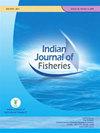基于营养膜技术(NFT)的鱼菜共生中罗勒(Ocimum basilicum L.)对鲮鱼(Pangasianodon hypophthalmus)幼苗的放养密度优化
IF 0.3
4区 农林科学
Q4 FISHERIES
引用次数: 0
摘要
进行了一项为期 90 天的实验,以优化基于营养膜技术(NFT)的鱼菜共生中罗勒(Pangasianodon hypophthalmus)的放养密度。该试验有四个处理,分别为 T1(2.5 千克/米-3)、T2(2.75 千克/米-3)、T3(3.0 千克/米-3)和 T4(3.25 千克/米-3),鱼芒的放养密度分别为 2.5 千克/米-3、2.75 千克/米-3、3.0 千克/米-3 和 3.25 千克/米-3,植物密度恒定为 24 株/米-2,对照组为 C(2.5 千克/米-3,不含植物)。在 T4 和 T3 中,罗勒叶片的宏量和微量营养素含量存在显著差异(p0.05)。生理参数(血液学、血清生化和抗氧化应激酶)均在可接受范围内。考虑到水质参数、鱼类生长、鱼类总生物量、鱼类生理反应、罗勒产量和营养成分含量,建议罗勒-鲮鱼鱼菜共生的放养密度为 3.00 kg m-3(鲮鱼)加 24 株 m-2 罗勒。关键词:鱼菜共生;养殖废水;罗勒;营养膜技术;鲮鱼本文章由计算机程序翻译,如有差异,请以英文原文为准。
Stocking density optimisation of pangasius (Pangasianodon hypophthalmus) fingerlings with basil (Ocimum basilicum L.) in nutrient film technique (NFT) based aquaponics
An experiment for 90 days was performed to optimise the stocking density of pangasius(Pangasianodon hypophthalmus) with basil (Ocimum basilicum L.) in a nutrient film technique(NFT) based aquaponics. The experiment had four treatments with different stockingdensities of pangasius as T1 (2.5 kg m-3), T2 (2.75 kg m-3), T3 (3.0 kg m-3) and T4 (3.25 kg m-3)with a constant plant density of 24 plants m-2 and control viz., C (2.5 kg m-3 withoutplants). Significant (p<0.05) difference in final body weight of fish was found among thetreatments and control. The highest fish biomass was recorded in T3 (10.29±4.41 kg m-3)followed by T4, T2, T1 and C. The highest plant yield was found in T4 (510.90±6.25 g);however, no significant difference was found between T4 and T3. No significant (p>0.05)difference in macro and micronutrient content of basil leaves was recorded in T4 and T3.The physiological parameters (hematological, serum biochemical and anti-oxidant stressenzymes) were found to be within the acceptable range. Considering the water qualityparameters, fish growth, total biomass of fish, fish physiological responses, basil yield andnutrient content, the stocking density of 3.00 kg m-3 (pangasius) with 24 plants m-2 of basilcould be recommended for basil-pangasius aquaponics. Keywords:Aquaponics, Aquaculture wastewater, Basil,Nutrient film technique, Pangasius
求助全文
通过发布文献求助,成功后即可免费获取论文全文。
去求助
来源期刊

Indian Journal of Fisheries
FISHERIES-
CiteScore
0.90
自引率
20.00%
发文量
0
审稿时长
6-12 weeks
期刊介绍:
Indian Journal of Fisheries is published quarterly by the Indian Council of Agricultural Research (ICAR), New Delhi. Original contributions in the field of Fish and fisheries science are considered for publication in the Journal. The material submitted must be unpublished and not under consideration for publication elsewhere.
Papers based on research which kills or damages any species, regarded as thratened/ endangered by IUCN crieteria or is as such listed in the Red Data Book appropriate to the geographic area concerned, will not be accepted by the Journal, unless the work has clear conservation objectives.
 求助内容:
求助内容: 应助结果提醒方式:
应助结果提醒方式:


